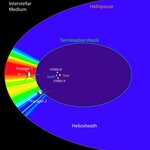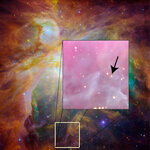Space

NASA's sun-focused STEREO spacecraft unexpectedly detected particles from the edge of the solar system last year, allowing University of California, Berkeley, scientists to map for the first time the energized particles in the region where the hot solar wind slams into the cold interstellar medium.
Mapping the region by means of neutral, or uncharged, atoms instead of light "heralds a new kind of astronomy using neutral atoms," said Robert Lin, UC Berkeley professor of physics and lead for the suprathermal electron sensor aboard STEREO. "You can't get a global picture of this region, one of…

If you're a long-time reader of this site, you might get the idea that Albert Einstein was a pretty smart guy - that comes across because he tends to proven right a lot even today.
PSR J0737-3039A/B is a unique system of two dead stars, pulsars, and one of the pair is 'wobbling' in space just like a spinning top, according to a team of researchers. The effect, called precession, was predicted by Albert Einstein and is yet another confirmation of his theory.
The binary pulsars were formed when a pair of massive stars exploded and their cores collapsed to create objects whose mass is greater…

A few years ago Voyager 1 entered the final frontier, that place where the solar wind becomes denser and hotter and pressure from gas between stars causes it to slow - the Termination Shock.
Now that Voyager 2 has reached its edge of the solar system, just under 7 billion miles from Earth, it has confirmed what astrophysicists had believed - the conflict between the solar wind and the interstellar wind has made that part of the solar system slightly squashed.
Image Credit: NASA/Walt Feimer
To envision the Sun's presence in the Milky Way galaxy, think of a ship plowing through the ocean,…

Homer's Odyssey, be it history or fiction, had one potentially true part that has fascinated readers throughout the ages - namely whether Odysseus returned home to experience a total solar eclipse.
Total eclipses, when the moon briefly but completely blocks the sun, happen pretty rarely. In fact, they're so rare that if what Homer describes is truly an eclipse, it could potentially help historians date the fall of Troy, which was purported to occur around the time of the events described in the Iliad and the Odyssey.
After arguing about the point for hundreds of years, historians,…

Two stars, each with the same mass and in orbit around each other, are twins that one would expect to be identical. So astronomers were surprised when they discovered that twin stars in the Orion Nebula, a well-known stellar nursery 1,500 light years away, were not identical at all. In fact, these stars exhibited significant differences in brightness, surface temperature and possibly even size.
The study published in the June 19 Nature suggests that one of the stars formed significantly earlier than its twin. Because astrophysicists have assumed that binary stars form simultaneously, the…

Today, at an international conference, a team of European astronomers announced they have found a triple system of 'super-Earths' around the star HD 40307, called such because they are more massive than the Earth but less massive than Uranus and Neptune (about 15 Earth masses.)
These super-Earths are around a rather normal star, which is slightly less massive than our Sun, and is located 42 light-years away towards the southern Doradus and Pictor constellations.
Looking at their entire sample studied with HARPS, the astronomers count a total of 45 candidate planets with a mass below 30 Earth…

Almost two years after the International Astronomical Union (IAU) General Assembly introduced the category of dwarf planets, the IAU, as promised, has decided on a name for transneptunian dwarf planets similar to Pluto.
The name plutoid was proposed by the members of the IAU Committee on Small Body Nomenclature (CSBN), accepted by the Board of Division III, by the IAU Working Group for Planetary System Nomenclature (WGPSN) and approved by the IAU Executive Committee at its recent meeting in Oslo, Norway.
Plutoids are celestial bodies in orbit around the Sun at a distance greater than that of…

Brown dwarfs, "failed stars", are a class of objects that represent the missing link between the lowest-mass stars and the gas-giant planets, such as Jupiter and Saturn. Brown dwarfs are the faintest and coolest objects that can be directly observed outside the solar system, emitting as little as 1/300,000th of the energy of the sun and having surface temperatures around 800° F - that's the temperature of a pizza oven and more than 9,000° F cooler than the surface of the sun.
Astronomers have used ultrasharp images obtained with the Keck Telescope and Hubble Space Telescope to determine for…

"The universe is a big place, and weird things can happen. I was flipping through archived Spitzer data of the object, and that's when I noticed it was surrounded by a ring we'd never seen before, "said Stephanie Wachter of NASA's Spitzer Science Center at the California Institute of Technology about a mysterious infrared ring a dead star that displays a magnetic field trillions of times more intense than Earth's.
NASA's Spitzer Space Telescope detected the ring around magnetar SGR 1900+14 at two narrow infrared frequencies in 2005 and 2007. The ringed magnetar is of a type called a soft…

ESO's VLT has allowed astronomers to determine that WOH G64, a red supergiant star almost 2,000 times as large as our Sun located 163,000 light-years away in the Large Magellanic Cloud, weighs almost half of what was previously thought, thereby solving the mystery of its existence.
The behemoth star is found to be surrounded by a massive and thick torus of gas and dust, and is most likely experiencing unstable, violent mass loss.
"Previous estimates gave an initial mass of 40 times the mass of the Sun to WOH G64. But this was a real problem as it was way too cold, compared to what…